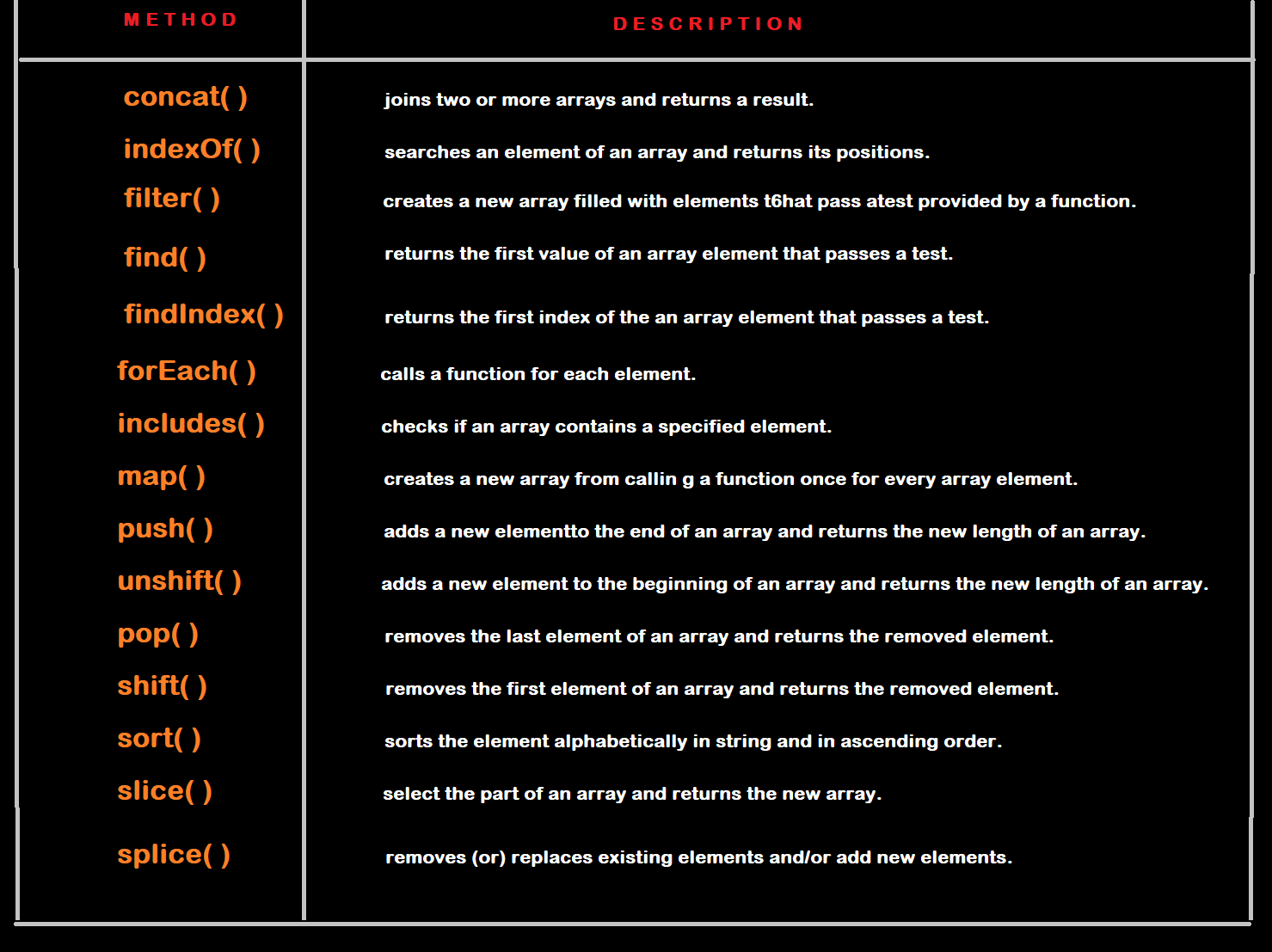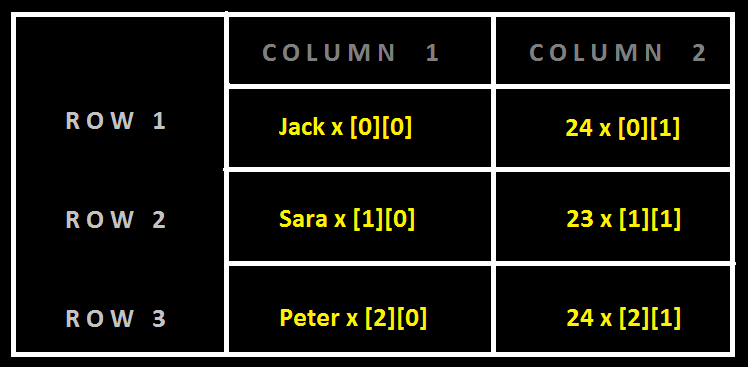Decoding Arrays In Java Script
 Arpit Dubey
Arpit DubeyTable of contents
- Agenda
- Create an Array
- Access Elements of an Array
- Add an Element to an Array
- Change the Elements of an Array
- Remove an Element from an Array
- Array length
- Array Operations
- Working on JavaScript Arrays
- Create a Multidimensional Array
- Access Elements of an Array
- Remove an Element from a Multidimensional Array
- Iterating over Multidimensional Array
- forEach
- map

Hola! Coders 👨💻 Hope you all are doing well, In this article, I'm going to give an introduction to arrays, their properties, operations, and methods let's see what the agenda of this blog is :
Agenda
Introduction to Arrays
Array Properties
Array Operations
Inbuilt Array Functions
Array Methods
Introduction to Arrays
Array: An array is an object that can store multiple values at once.
For example,
const words = ['hello', 'world', 'ineuron'];
//for iterating items through the array
for(let word in words)
console.log(`${parseInt(word)+1} : ${words[word]}`);
// It will give/show the array on console/Terminal.
Here, the variable name "words" is an array. The array is storing 3 values.
Create an Array
You can create an array using two ways:
1. Using an array literal
The easiest way to create an array is by using an array literal []. For example,
const courses = ["Full Stack Javascript Bootcamp 2.0", "Full Stack Datascience", "Full Stack Blockchain Developer", "Full Stack Java Developer", "Full stack Big Data Developer"];
2. Using the new keyword
You can also create an array using JavaScript new keyword.
const courses = new Array("Full Stack Javascript Bootcamp 2.0", "Full Stack Datascience", "Full Stack Blockchain Developer", "Full Stack Java Developer", "Full stack Big Data Developer");
In both of the above examples, we have created an array having two elements.
Note: It is recommended to use an array literal to create an array.
Here are more examples of arrays:
// empty array
const emptyArray = [ ];
// array of numbers
const evenNumberArray = [2, 4, 6, 8];
// array of strings
const stringArray = ["Full Stack Javascript Bootcamp 2.0", "Full Stack Datascience", "Full Stack Blockchain Developer"];
// array with mixed data types
const newData = ["Full Stack Javascript Bootcamp 2.0", "Full Stack Datascience", 17700, true];
You can also store arrays, functions and other objects inside an array. For example,
const newData = [
{'task1': 'exercise'},
[1, 2 ,3],
function hello() { console.log('hello')}
];
Access Elements of an Array
You can access elements of an array using indices (0, 1, 2 …). For example,
const myArray = ['h', 'e', 'l', 'l', 'o'];
// first element
console.log(myArray[0]); // "h"
// second element
console.log(myArray[1]); // "e"

Array indexing in JavaScript
Note: Array's index starts with 0, not 1.
Add an Element to an Array
You can use the built-in method push() and unshift() to add elements to an array.
The push() the method adds an element at the end of the array. For example,
let dailyActivities = ['eat', 'sleep'];
// add an element at the end
dailyActivities.push('exercise');
console.log(dailyActivities); // ['eat', 'sleep', 'exercise']
The unshift() the method adds an element at the beginning of the array. For example,
let dailyActivities = ['eat', 'sleep', 'code'];
//add an element at the start
dailyActivities.unshift('work');
console.log(dailyActivities); // ['work', 'eat', 'sleep', 'code']
Change the Elements of an Array
You can also add elements or change the elements by accessing the index value.
let dailyActivities = [ 'eat', 'sleep'];
// this will add the new element 'exercise' at the 2 index
dailyActivities[2] = 'exercise';
console.log(dailyActivities); // ['eat', 'sleep', 'exercise']
Suppose an array has two elements. If you try to add an element at index 3 (fourth element), the third element will be undefined. For example,
let dailyActivities = [ 'eat', 'sleep'];
// this will add the new element 'exercise' at the 3 index
dailyActivities[3] = 'exercise';
console.log(dailyActivities); // ["eat", "sleep", undefined, "exercise"]
If you try to add elements to high indices, the indices in between will have an undefined value.
Remove an Element from an Array
You can use the pop() method to remove the last element from an array. The pop() the method also returns the returned value. For example,
let dailyActivities = ['work', 'eat', 'sleep', 'exercise'];
// remove the last element
dailyActivities.pop();
console.log(dailyActivities); // ['work', 'eat', 'sleep']
// remove the last element from ['work', 'eat', 'sleep']
const removedElement = dailyActivities.pop();
//get removed element
console.log(removedElement); // 'sleep'
console.log(dailyActivities); // ['work', 'eat']
If you need to remove the first element, you can use the shift() method. The shift() , the method removes the first element and also returns the removed element. For example,
let dailyActivities = ['work', 'eat', 'sleep'];
// remove the first element
dailyActivities.shift();
console.log(dailyActivities); // ['eat', 'sleep']
Array length
You can find the length of an element (the number of elements in an array) using the length property. For example,
const dailyActivities = [ 'eat', 'sleep'];
// this gives the total number of elements in an array
console.log(dailyActivities.length); // 2
Array Operations
In JavaScript, there are various array methods available that make it easier to perform useful calculations.
Some of the commonly used JavaScript array methods are:

Example: JavaScript Array Methods
let dailyActivities = ['sleep', 'work', 'exercise']
let newRoutine = ['eat'];
let ages = [4, 9, 16, 25, 36, 49];
// sorting elements in the alphabetical order
dailyActivities.sort();
console.log(dailyActivities); // ['exercise', 'sleep', 'work']
//finding the index position of string
const position = dailyActivities.indexOf('work');
console.log(position); // 2
// slicing the array elements
const newDailyActivities = dailyActivities.slice(1);
console.log(newDailyActivities); // [ 'sleep', 'work']
// concatenating two arrays
const routine = dailyActivities.concat(newRoutine);
console.log(routine); // ["exercise", "sleep", "work", "eat"]
// filter an array
const adults = ages.filter(checkAdult);
function checkAdult(age) {
return age >= 18;
}
console.log(adults); // [25, 36, 49]
//map a function to an array
const ages_sqrt = ages.map(Math.sqrt)
console.log(ages_sqrt); // [2, 3, 4, 5, 6, 7]
Note: If the element is not in an array, indexOf() gives -1.
Working on JavaScript Arrays
In JavaScript, an array is an object. And, the indices of arrays are object keys.
Since arrays are objects, the array elements are stored by reference. Hence, when an array value is copied, any change in the copied array will also reflect in the original array. For example,
let arr = ['h', 'e'];
let arr1 = arr;
arr1.push('l');
console.log(arr); // ["h", "e", "l"]
console.log(arr1); // ["h", "e", "l"]
You can also store values by passing a named key in an array. For example,
let arr = ['h', 'e'];
arr.name = 'John';
console.log(arr); // ["h", "e"]
console.log(arr.name); // "John"
console.log(arr['name']); // "John"

Array indexing in JavaScript
However, it is not recommended to store values by passing arbitrary names in an array.
Hence in JavaScript, you should use an array if values are in an ordered collection. Otherwise, it's better to use an object with { }.
A multidimensional array is an array that contains another array. For example,
// multidimensional array
const data = [[1, 2, 3], [1, 3, 4], [4, 5, 6]];
Create a Multidimensional Array
Here is how you can create multidimensional arrays in JavaScript.
Example 1
let studentsData = [['Jack', 24], ['Sara', 23], ['Peter', 24]];
Example 2
let student1 = ['Jack', 24];
let student2 = ['Sara', 23];
let student3 = ['Peter', 24];
// multidimensional array
let studentsData = [student1, student2, student3];
Here, both example 1 and example 2 create a multidimensional array with the same data.
Access Elements of an Array
You can access the elements of a multidimensional array using indices (0, 1, 2 …). For example
let x = [
['Jack', 24],
['Sara', 23],
['Peter', 24]
];
// access the first item
console.log(x[0]); // ["Jack", 24]
// access the first item of the first inner array
console.log(x[0][0]); // Jack
// access the second item of the third inner array
console.log(x[2][1]); // 24
You can think of a multidimensional array (in this case, x), as a table with 3 rows and 2 columns.

Accessing multidimensional array elements.
Add an Element to a Multidimensional Array
You can use Array's push() method or an indexing notation to add elements to a multidimensional array.
Adding Element to the Outer Array
let studentsData = [['Jack', 24], ['Sara', 23],];
studentsData.push(['Peter', 24]);
console.log(studentsData); //[["Jack", 24], ["Sara", 23], ["Peter", 24]
Adding Element to the Inner Array
// using index notation
let studentsData = [['Jack', 24], ['Sara', 23],];
studentsData[1][2] = 'hello';
console.log(studentsData); // [["Jack", 24], ["Sara", 23, "hello"]]
// using push()
let studentsData = [['Jack', 24], ['Sara', 23],];
studentsData[1].push('hello');
console.log(studentsData); // [["Jack", 24], ["Sara", 23, "hello"]]
You can also use Array's splice() method to add an element at a specified index. For example,
let studentsData = [['Jack', 24], ['Sara', 23],];
// adding element at 1 index
studentsData.splice(1, 0, ['Peter', 24]);
console.log(studentsData); // [["Jack", 24], ["Peter", 24], ["Sara", 23]]
Remove an Element from a Multidimensional Array
You can use Array's pop() method to remove the element from a multidimensional array. For example,
Remove Element from Outer Array
// remove the array element from outer array
let studentsData = [['Jack', 24], ['Sara', 23],];
studentsData.pop();
console.log(studentsData); // [["Jack", 24]]
Remove Element from Inner Array
// remove the element from the inner array
let studentsData = [['Jack', 24], ['Sara', 23]];
studentsData[1].pop();
console.log(studentsData); // [["Jack", 24], ["Sara"]]
You can also use the splice() method to remove an element at a specified index. For example,
let studentsData = [['Jack', 24], ['Sara', 23],];
// removing 1 index array item
studentsData.splice(1,1);
console.log(studentsData); // [["Jack", 24]]
Iterating over Multidimensional Array
You can iterate over a multidimensional array using Array's forEach() method to iterate over the multidimensional array. For example,
let studentsData = [['Jack', 24], ['Sara', 23],];
// iterating over the studentsData
studentsData.forEach((student) => {
student.forEach((data) => {
console.log(data);
});
});
Output
Jack
24
Sara
23
The first forEach() the method is used to iterate over the outer array elements and the second forEach() is used to iterate over the inner array elements.
You can also use the for...of loop to iterate over the multidimensional array. For example,
let studentsData = [['Jack', 24], ['Sara', 23],];
for (let i of studentsData) {
for (let j of i) {
console.log(j);
}
}
You can also use the for loop to iterate over a multidimensional array. For example,
let studentsData = [['Jack', 24], ['Sara', 23],];
// looping outer array elements
for(let i = 0; i < studentsData.length; i++){
// get the length of the inner array elements
let innerArrayLength = studentsData[i].length;
// looping inner array elements
for(let j = 0; j < innerArrayLength; j++) {
console.log(studentsData[i][j]);
forEach
Iterates through the elements in an array.
Executes a callback for each element.
Does not return a value.
const a = [1, 2, 3];
const doubled = a.forEach((num, index) => {
// returning 2 x values of each element
return num * 2;
});
console.log(doubled);
// doubled = undefined
map
Iterates through the elements in an array.
"Maps" each element to a new element by calling the function on each element, creating a new array as a result.
const a = [1, 2, 3];
const doubled = a.map(num => {
return num * 2;
});
console.log(doubled);
// doubled = [2, 4, 6]
The main difference between .forEach and .map() is that .map() returns a new array. If you need the result, but do not wish to mutate the original array, .map() is a clear choice. If you simply need to iterate over an array, forEach is a fine choice.
Subscribe to my newsletter
Read articles from Arpit Dubey directly inside your inbox. Subscribe to the newsletter, and don't miss out.
Written by

Arpit Dubey
Arpit Dubey
A Full Stack Web Developer who is familiar with java, python, Java script, AI, ML & DL. Block chain and I'm ENFJ-A so, feel free to talk. Thank you